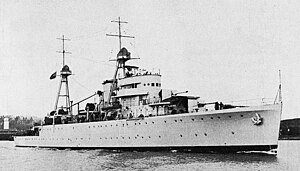NRP Afonso de Albuquerque (1934)
 Afonso de Albuquerque in 1935
| |
| History | |
|---|---|
| Name | Afonso de Albuquerque |
| Namesake | Afonso de Albuquerque |
| Builder | Hawthorn Leslie |
| Launched | 1934 |
| Commissioned | 28 May 1934 |
| Fate | Destroyed in combat in 1961 |
| General characteristics | |
| Class and type | Afonso de Albuquerque class |
| Displacement |
|
| Length | 100 m (328 ft 1 in) |
| Beam | 13.49 m (44 ft 3 in) |
| Draught | 3.81 m (12 ft 6 in) |
| Propulsion |
|
| Speed | 21 knots (39 km/h) |
| Range | 8,000 mi (13,000 km) at 10 knots (19 km/h) |
| Complement | 191 |
| Armament |
|
| Aircraft carried | 1 |
The ship was the first of the Afonso de Albuquerque class, which also included NRP Bartolomeu Dias. These ships were classified, by the Portuguese Navy, as avisos coloniais de 1ª classe (1st class colonial aviso or sloop) and were designed to maintain a Portuguese naval presence in the Overseas territories of Portugal. They had limited capacity to combat other surface vessels, as they were intended, mainly, to support amphibious operations and troops on land.
After the
In her career Afonso de Albuquerque served mainly in the
History
1936 mutiny
On 8 September 1936 the crews of Afonso de Albuquerque and the destroyer Dão mutinied while anchored in Lisbon harbour. Opposed to the Salazar dictatorship's support of the Nationalists rebels against the pro-government Republicans in the Spanish Civil War, the sailors confined their officers and declared their solidarity with the Spanish Republic. As the ships were leaving the Tejo estuary they were fired upon by the batteries from the forts and both Afonso de Albuquerque and Dão received direct hits and were grounded.[1] Some of the sailors were killed while trying to flee, but most of the sailors were arrested and sent to the penal colony of Tarrafal in Portuguese Cape Verde. After the mutiny was put down the government claimed that the sailors had prepared to sail to Spain in order to assist the Spanish Republic.[2]
RMS Nova Scotia
On 28 November 1942, Afonso de Albuquerque was in
Five survivors fired a
Timor
In December 1941 Australian and Dutch forces occupied Portuguese Timor with the stated purpose of defending the territory against possible Japanese invasion. In February 1942, in response to the Australian and Dutch occupation, Japanese forces invaded Timor.
Japanese forces occupied Timor until the end of the Second World War, at the end of which Portugal sent a naval and military expedition to re-occupy and reconstruct East Timor. Afonso de Albuquerque escorted the 7,884 GRT troopship Angola, which carried the first Portuguese troops of the expedition, reaching Timor on 29 September 1945.
Goa
Late in 1961, unable to convince Portugal to relinquish its integrated territories in the Indian subcontinent, India launched
Early on the morning of 18 December 1961 Afonso de Albuquerque received information that the Indian Armed Forces had launched Operation Vijay. Her crew went to battle stations. As the land communication infrastructure was bombed and destroyed by the Indian Air Force, Afonso de Albuquerque received the responsibility to maintain radio communications between Goa and Lisbon.
At 09:00, Afonso de Albuquerque sighted three Indian Navy ships, led by the Leopard-class frigate INS Betwa, just outside the Mormugao port. The two frigates and a minesweeper were an advance group of a task force which included the light aircraft carrier INS Vikrant and about ten light cruisers, destroyers, frigates and minesweepers.
At 12:00, as the Portuguese commanders refused to surrender, INS Betwa and her
At 12:35, under massive fire and with her boilers and engines already destroyed, the frigate's crew ran her aground onto the beach to serve as a shore battery. The crew continued to resist and fight until about the 14:10. The crew was captured by Indian forces on the next day at 20:30.
It is estimated that during her last combat Afonso de Albuquerque fired almost 400 shells. On the Indian Union side, two frigates were hit, killing five sailors and injuring thirteen,[6] but the advantage of the Indian Navy was significant, as their ships were more modern.
Afonso de Albuquerque lay grounded at the beach near
References
- ^ The Sydney Morning Herald, Friday 2 October 1936, p. 17
- James Maxwell Anderson, The History of Portugal, p. 146
- ^ a b c d Helgason, Guðmundur (1995–2013). "Nova Scotia". uboat.net. Guðmundur Helgason. Retrieved 29 March 2013.
- ^ Bezuidenhout, Leon (March 2008). Pieter Snyman, Springbok-soldier 1940-43 (PDF). translated from Afrikaans by JC Hough & MJ Conradie. p. 13.
- ^ a b Colao, Alex (28 November 2011). "Anniversary of Nova Scotia – Alessandro Cerrato". Alex Colao Blog.
- ^ Revista de Marinha: Três Navios Históricos
- ^ [1][dead link]
Bibliography
- Sturton, Ian (2005). "Question 6/94: Loss of Portuguese Sloop". Warship International. XLII (1): 26–27. ISSN 0043-0374.
External links
- Jane's Fighting Ships 1938, p. 398.
- Area Militar: the Afonso de Albuquerque
- Revista da Armada 2001
